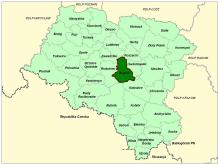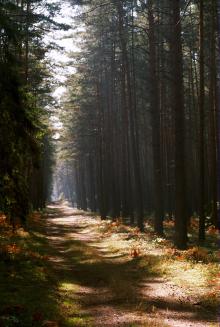Polish forests
Poland is in the European lead, while concerning the area of all forests. They cover about 29,2 % of the country territory, and grow within the area of 9,1 million hectares. The overwhelming majority of the forests is state owned, of which almost 7,6 million hectares are managed by the State Forests National Forest Holding..
The number of Polish forest is still growing. The forestation rate of the country has increased from 21 % in 1945 to 29,2 % at the moment. Between 1995 and 2008, the forest area increased by 310 thousand ha. The basis for afforestation works is the "National Programme for Increasing the Forest Cover" (KPZL), assuming an increase of the forestation rate up to 30 % by 2020 and up to 33 % by 2050. Polish forests abound in flora, fauna and fungi. 65 % of the total number of animal species live there.
The forests grow in our country on poor soils, mainly because of the development of the agriculture in previous years. It influences the distribution of the types of the forest sites in Poland. Over 55 % of the forest areas is covered with coniferous forests. In other areas, there are forest sites, mainly the mixed ones. Their small part constitute alder and riparian forests – not more than 3 %.
In the years 1945 – 2011 the area of natural deciduous tree stands within the area of the State Forests National Forest Holding increased from 13 to 28,2 %.
Within the lowlands and uplands the most often occurring tee species is pine. It covers 64,3 % of the forest area of the State Forests National Forest Holding and 57,7 % of private and commune forests. In the mountains the predominant species is European spruce ( in the west) and European spruce with beech (in the east). Domination of pine is the result of carrying on sustainable forest management in the past. Once, the monocultures (crops or cultivations of one species) were the answer to the great demand of industry for wood. Such forests appeared to be quite fragile to climatic factors. They also were often the prey of pests' expansion.
In Polish forests, the share of other tree species, especially deciduous trees have been systematically increasing. The foresters have stepped aside from monocultures – that is why, they try to fit specific species of the forest stand to the natural stand, that would be proper for the given area. Thanks to that, in the years 1945 – 2011, the area of the deciduous tree stands within the lands of the State Forests National Forest Holding increased from 13 to 28,2 %. There occur more and more frequently the following tree species: oaks, ashes, maples, sycamore maples, elms, but also birches, beeches, alders, poplars, hornbeams, aspens, tilias and willows.
Our forests are the most often represented by the forest stands aged 40 to 80 years. The average age of the forest equals 60 years. More and more trees are of big size at the age over 80 years. Since the end of the Second World War, the forests' area has increased up to almost 1,85 million hectares.
Raport o stanie lasów w Polsce 2012
 Asset Publisher
Asset Publisher
Jak dokarmiać ptaki zimą?
Jak dokarmiać ptaki zimą?
Właśnie spadł pierwszy śnieg – to doskonały moment,żeby opowiedzieć szerzej o dokarmianiu.
Pracownicy naszego Nadleśnictwa, jak co roku, opowiadają o tym dzieciom odwiedzającym naszą ścieżkę przyrodniczą. Dajemy też dobry przykład – nasi leśnicy już dzisiaj mają w pogotowiu ptasie przysmaki. Tym z państwa, którzy zastanawiają się nad dołączeniem do grona przyjaciół ptaków, przypominamy podstawowe zasady.
Dobra lokalizacja to podstawa!
Decydując się pomóc skrzydlatym przyjaciołom w przetrwaniu zimy pamiętajmy o tym, żeby umieścić karmik w miejscu, gdzie nie dostaną się do niego drapieżniki. Najlepiej, żeby było osłonięte od wiatru i zaciszne, ale o konstrukcji umożliwiającej ucieczkę w razie zagrożenia. Dobrze, jeśli w pobliżu są gęste krzewy dające schronienie. Pamiętajmy także, że karmik należy regularnie czyścić aby nie dopuścić do rozprzestrzeniania się ptasich chorób. Pomaga w tym zamontowanie tacki lub zdejmowanej podłogi.
Jeśli nie używamy karmika, wykładajmy jedzenie zawsze w tym samym miejscu. Ptaki szybko się nauczą, gdzie znajduje się stołówka
Karmić, ale kiedy?
Dziko żyjące zwierzęta powinny zdobywać pokarm samodzielnie. Kiedy warunki atmosferyczne pozwalają na naturalny żer, dokarmianie ptaków może być dla nich niekorzystne. Zbyt wczesne rozpoczęcie dokarmiania zaburza wędrówki łabędzi i kaczek, które mają później problemy z przetrwaniem zimy. Tak więc zaczynamy, kiedy pokrywa śnieżna uniemożliwia żerowanie. Robimy to regularnie, początkowo w małych porcjach, żeby pokarm się nie zepsuł. Przyzwyczajenie do stałego miejsca, w którym nagle przestaje się pojawiać pożywienie może być dla ptaków zgubne. Poszukiwania na mrozie pochłaniają cenną energię.
No i czym dokarmiać?
Do karmienia używajmy tylko naturalnych produktów, nie przetworzonych przez człowieka!
Dla wielu ptaków przysmakiem jest tłuszcz zwierzęcy (słonina lub łój), a także zalane roztopionym tłuszczem nasiona i orzechy - tzw. ptasie pyzy, które można kupić w sklepie zoologicznym lub przygotować samodzielnie
Pieczywo czy resztki z obiadu to nienajlepszy pomysł na dokarmianie ptaków. Ptakom nie wolno podawać soli (solona słonina, orzeszki). Niebezpieczne są także produkty zepsute lub spleśniałe czy namoczony i zamarznięty chleb. Nie podajemy także pęczaku i innych produktów pęczniejących w przewodzie pokarmowm. Głodne ptaki zjedzą wszystko, ale skutki mogą być dla nich tragiczne.
Zimowa stołówka przyciąga różne gatunki, dlatego trudno określić uniwersalną karmę. Najlepiej podać nasiona słonecznika (łuskane lub w łupinach), konopie czy zboża.
Zachęcamy do świadomego dokarmiania. Pomagajmy naturze mądrze i odpowiedzialnie.


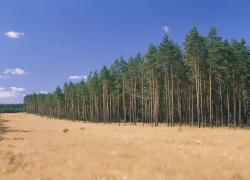 fot. Paweł Fabijański
fot. Paweł Fabijański
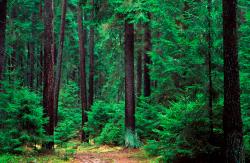 fot. Paweł Fabijański
fot. Paweł Fabijański
 fot. Paweł Fabijański
fot. Paweł Fabijański

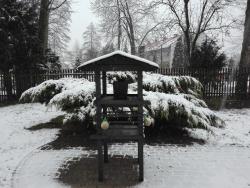 fot. A. Ciężarek. Karmik przy biurze Nadleśnictwa
fot. A. Ciężarek. Karmik przy biurze Nadleśnictwa
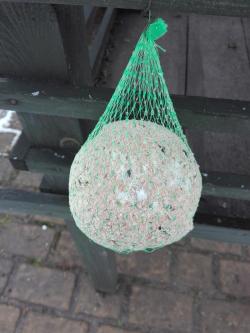 fot. A. Ciężarek. "ptasia pyza"
fot. A. Ciężarek. "ptasia pyza"
